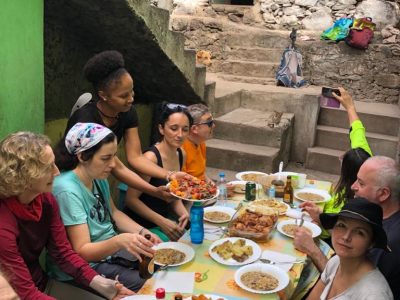The traditions of Santo Antão that thusands fall in love with
Let us tell you a short story.
Local legend says that when God created the world, on the last day, He was so ecstatic with happiness that he began to cry with joy.
Each of these tears concerns each of the 10 islands of the Cape Verde archipelago.
It is believed that for this reason, both the islands and their people are blessed and protected.
Each island has a unique personality, but what they all have in common is Cape Verde’s cultural wealth.
Below we share some of the characteristics that distinguish the island of Santo Antão.
Dance
In Cape Verde there are several dance styles, such as morna, coladeira, and funaná.
The three styles are considered common to all Cape Verdeans, even in the diaspora.
The most traditional dance of Santo Antão is the colá.
As a dance, the colá is traditionally performed in a street parade. Pairs of dancers perform a movement marked by the strong tempo of the rhythm, with twirls, with advances and retreats, and then violently touching each other in the pelvic area.
Gastronomy
Being an island endowed with numerous typical products, its gastronomy is a real motivation for visitors and inhabitants, considering that agriculture and fishing are its main activities.
The gastronomic options are varied and of quality, both in fish and meat dishes. In addition to the traditional cachupa, one of the traditional recipes with a prominent place in the kitchen considered by many to be the true and main delicacy, in Santo Antão the seafood dishes also have a place on the podium. Additionally, one of the most appreciated recipes is the goat and bean stew.
In addition to the food, the traditional jams, papaya, banana, guava, coconut sweets, among others, are also known.
Cheese production is also noteworthy, becoming one of the main attractions of those who visit the island, taking the opportunity to get to know the production of this “terra-terra” product.
However, the first place goes to the typical drinks, which delight everyone. Examples of this are grogue (made from rum, water, and sugar), considered the best in the entire archipelago, or pontche (made from grogue, which can have the most varied flavors: honey, coconut, vanilla, chocolate, strawberry, etc.) and the liqueurs that complete the lunch serving as a digestive.
Music
After the language, music is the richest and most universal manifestation of Santo Antão’s culture.
The music of Santo Antão is based on all the stories and beliefs of the island, highlighting themes such as joys and sorrows, encounters and separations, land and sea, hunger and abundance, loneliness and celebration, the longing (“saudade”) and love.
All these feelings are represented in the songs that always end up turning into celebration, as the Cape Verdean people always keep a smile on their faces, no matter how challenging the situation they’re dealing with.
Religious festivals (Son Jon)
Tradition is still a living force in the people of Santo Antão, and cultural manifestations have been celebrated for a long time.
These cultural events also contribute to the island’s economic movement, due to the intense flow of people who arrive this month to live or relive these festivities.
Music festivals – Seven Suns Seven Moons Festival – Ribeira Grande
In the city of Ribeira Grande, Santo Antão, the Festival Sete Sois Sete Luas (Seven Suns Seven Moons Festival) takes place every year, a project that brings to Cape Verde great artists from the Mediterranean and Portuguese-speaking world, who leave their mark through paintings on the city walls.
It is held every year in early October, creating its genre and discovering new ways to reinterpret popular tradition to make it more appreciated, filled with new styles and musical mixtures, and promoting unprecedented artistic collaborations.
Painting (Ribeira Grande)
Santo Antão is surrounded by artistic paintings on the walls, mainly in the city of Ribeira Grande.
Most of these paintings were made by international artists participating in the Sete Sois Sete Luas music festival.
The paintings portray famous characters in Cape Verdean music, such as Cesária Évora, Ildo Lobo, among others.





